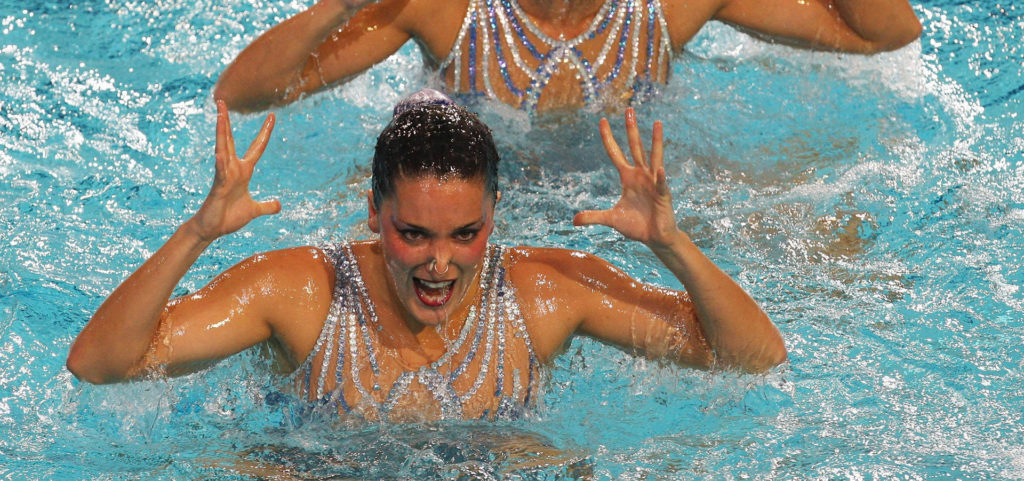
Synchronized swimming is an aquatic sport that combines swimming, dance, and gymnastics. Performers, known as synchronized swimmers, execute choreographed routines in the water while synchronized to music. It is a sport that requires strength, flexibility, artistry, and precise timing.
The Origins of Synchronized Swimming
Synchronized swimming has its origins in water ballet which became popular in the late 19th and early 20th centuries. Water ballet consisted of swimmers executing graceful moves and patterns in the water accompanied by music. In the 1920s and 1930s, water ballet evolved into “rhythmic swimming” which featured swimmers moving more athletically in time to music.
In the 1950s, rhythmic swimming adopted more elaborate choreography and athleticism, leading to the official creation of synchronized swimming. The first competitions took place in Canada in the 1950s. Synchronized swimming debuted as an Olympic sport at the 1984 Summer Games in Los Angeles. Since then, it has continued to grow in popularity and athleticism.
Performing Synchronized Swimming Routines
Synchronized swimmers perform two types of routines – solo routines featuring a single swimmer and team routines with 4-8 swimmers. Solo routines last 2-3 minutes while team routines last 4-5 minutes. Synchronized swimming routines incorporate elements of:
- Choreography – Swimmers execute synchronized movements, patterns, and transitions set to music. Routines feature complex choreography with swimmers constantly interacting and changing formations.
- Acrobatics – Swimmers perform acrobatic moves and lifts, requiring strength, flexibility and balance. Common moves include spins, throws, platforms, and hybrids above and below the surface.
- Artistic Swimming – Swimmers utilize traditional swimming strokes in creative ways to match the music. Arm and leg movements are extended and exaggerated.
- Underwater Work – Routines feature extensive underwater work. Swimmers hold their breath, execute movements, and transition between patterns underwater.
Routines are choreographed to music which provides structure, mood, and helps swimmers synchronize their movements. Swimmers aim to perform routines with perfect synchronization, speed, and height above the water. Technical elements are combined with grace and artistry.
| Routine Type | Number of Swimmers | Length |
|---|---|---|
| Solo | 1 | 2-3 minutes |
| Team | 4-8 | 4-5 minutes |
Competitive Synchronized Swimming
There are synchronized swimming competitions at national, regional, and international levels. The highest level of competition is at the Olympic Games which features a duet event and team event. Major championships include the FINA World Championships and World Cup.
Competitors are judged on:
- Synchronization – How precisely swimmers coordinate their movements and timing
- Difficulty – The complexity of moves, patterns, and choreography
- Execution – How well elements are performed with strength, height, and control
- Artistic Impression – Choreography, interpretation, and matching movement to music
- Overall Performance – The total impact, enjoyment and essence of the routine
Scoring is on a scale of 1 to 10. A perfect score is 10. Competitive routines are intensely choreographed, requiring immense skill, timing, and teamwork.
The Life of an Elite Synchronized Swimmer
To become an elite synchronized swimmer requires years of training. Most athletes begin the sport around age 8-12. Synchronized swimmers train 20-30 hours per week in the pool and land-based strength and flexibility exercises.
Key aspects of training include:
- Routines – Drilling choreographed routines repeatedly to perfect timing and movements
- Strength – Building core strength, leg strength, and stamina for difficult lifts and acrobatics
- Flexibility – Improving range of motion for splits and positions above the water
- Underwater Capacity – Increasing lung capacity and breath control through underwater training
- Choreography – Working with choreographers to integrate innovative moves and transitions
- Showmanship – Developing presentation and performance ability for maximum crowd engagement
Elite synchronized swimmers exhibit immense strength, flexibility, artistry, and precision in their performances. They make the difficult sport look graceful and effortless.
The Mental Demands of Synchronized Swimming
In addition to immense physical skills, synchronized swimming places huge mental demands on athletes. Key mental abilities include:
- Concentration – Staying focused for the entire demanding routine despite fatigue
- Memorization – Remembering intricate choreography and timing of every movement
- Composure – Remaining calm under pressure and recovering quickly from any mistakes
- Teamwork – Attuning completely to teammates and moving as a single unit
- Performance – Bringing showmanship and emotional expression to each performance
- Spatial Awareness – Maintaining excellent awareness of positioning in the water
Synchronized swimmers undergo intense mental preparation to deliver flawless performances under pressure. Their mental strength matches their physical ability.
Health Benefits of Synchronized Swimming
While performed at an elite level in competition, synchronized swimming also provides excellent health benefits as a recreational activity. As a low-impact sport, synchronized swimming can:
- Improve cardiovascular health and endurance
- Increase muscle strength and flexibility
- Enhance coordination, balance and body awareness
- Build breath control through underwater work
- Provide an enjoyable way to stay active
The teamwork aspect also bestows social and emotional benefits. Overall, recreational synchronized swimming offers a fun way for people of any age and skill level to gain fitness and friendships.
All in all, with its blend of athletics and artistry, synchronized swimming is a uniquely beautiful and demanding sport. Competitors make extremely strenuous feats look graceful and effortless. The sport continues to mesmerize audiences while requiring immense strength, flexibility, timing and teamwork from its elite athletes. Synchronized swimming combines the thrill of competition with the beauty of movement in water.